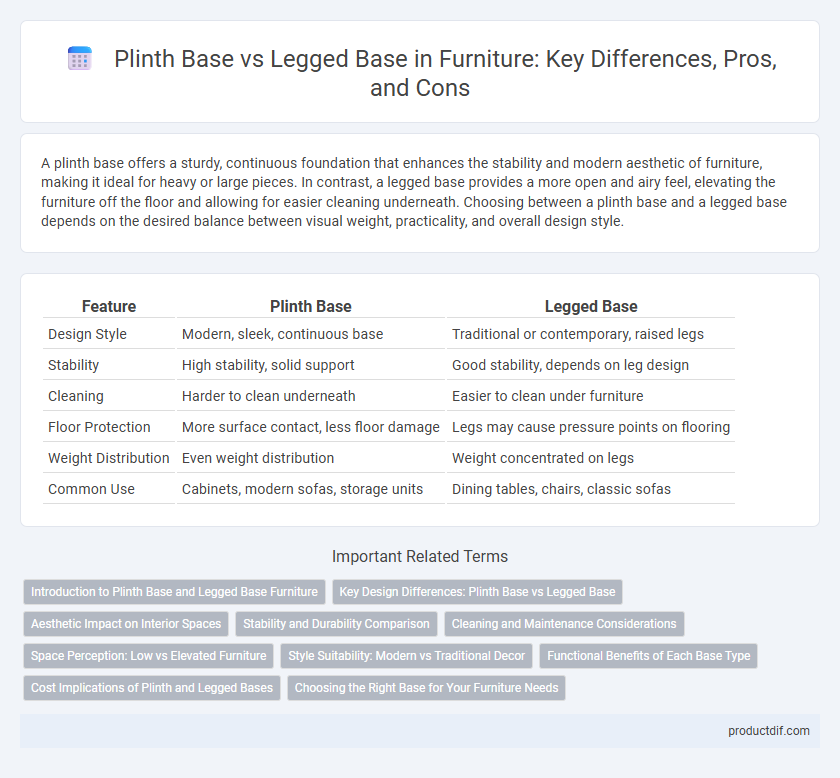A plinth base offers a sturdy, continuous foundation that enhances the stability and modern aesthetic of furniture, making it ideal for heavy or large pieces. In contrast, a legged base provides a more open and airy feel, elevating the furniture off the floor and allowing for easier cleaning underneath. Choosing between a plinth base and a legged base depends on the desired balance between visual weight, practicality, and overall design style.
Table of Comparison
| Feature | Plinth Base | Legged Base |
|---|---|---|
| Design Style | Modern, sleek, continuous base | Traditional or contemporary, raised legs |
| Stability | High stability, solid support | Good stability, depends on leg design |
| Cleaning | Harder to clean underneath | Easier to clean under furniture |
| Floor Protection | More surface contact, less floor damage | Legs may cause pressure points on flooring |
| Weight Distribution | Even weight distribution | Weight concentrated on legs |
| Common Use | Cabinets, modern sofas, storage units | Dining tables, chairs, classic sofas |
Introduction to Plinth Base and Legged Base Furniture
Plinth base furniture features a solid, continuous base that offers enhanced stability and a sleek, modern look by concealing legs and support structures. Legged base furniture includes distinct legs, often providing an elevated appearance and easier cleaning access under the piece. Choosing between plinth and legged bases impacts both aesthetic appeal and functional design in furniture selection.
Key Design Differences: Plinth Base vs Legged Base
Plinth bases provide a solid, continuous support that enhances stability and offers a sleek, modern aesthetic, often used in minimalist furniture designs. Legged bases feature individual legs that elevate the furniture, creating a lighter visual impression and allowing easier cleaning underneath. The choice between plinth and legged bases significantly impacts both the structural support and overall style of the furniture piece.
Aesthetic Impact on Interior Spaces
Plinth bases offer a sleek, continuous foundation that creates a modern, minimalist aesthetic by visually anchoring furniture to the floor and enhancing clean lines in interior spaces. Legged bases contribute an airy, elevated appearance, adding a sense of openness and lightness that complements traditional or eclectic decor styles. Selecting between plinth and legged bases influences not only the furniture's stability but also the room's spatial perception and overall design harmony.
Stability and Durability Comparison
Plinth bases provide superior stability due to their continuous, solid structure that evenly distributes weight and minimizes wobbling, making them ideal for heavy or frequently used furniture. Legged bases offer more flexibility and aesthetic variation but may sacrifice some durability as individual legs can loosen or warp over time under uneven pressure. In terms of long-term durability, plinth bases generally withstand wear and tear better, especially on uneven surfaces, whereas legged bases require regular maintenance to ensure stability.
Cleaning and Maintenance Considerations
Plinth bases offer a continuous, solid platform that prevents dust and debris from accumulating underneath, making cleaning simpler and more efficient. Legged bases, with their elevated design, allow easy access for vacuuming or mopping but tend to accumulate dust on legs requiring regular wiping. Maintenance of plinth bases typically involves less frequent cleaning, while legged bases demand routine attention to prevent dirt buildup on exposed supports.
Space Perception: Low vs Elevated Furniture
Plinth bases create a solid, grounded look that enhances the perception of stability and can make a room feel more compact by reducing visible floor space beneath furniture. Legged bases elevate furniture, allowing light and air to flow underneath, which visually expands the room and contributes to an open, airy atmosphere. Choosing between plinth and legged bases significantly impacts spatial perception, where plinth bases suit cozy environments and legged bases favor light-filled, spacious interiors.
Style Suitability: Modern vs Traditional Decor
Plinth bases offer a clean, minimalist silhouette ideal for modern and contemporary decor, emphasizing sleek lines and a grounded appearance. Legged bases provide a more classic and ornate look, complementing traditional or vintage styles with their visible structure and often detailed craftsmanship. Choosing between plinth and legged bases depends on the desired aesthetic harmony with the overall room design.
Functional Benefits of Each Base Type
A plinth base provides superior stability and support, making it ideal for heavy or bulky furniture pieces, while also offering a sleek, modern look that protects floors from scratches. A legged base allows for easier cleaning underneath and better airflow, contributing to furniture longevity and room ventilation. Choosing between the two depends on the desired balance of aesthetic appeal, ease of maintenance, and structural strength.
Cost Implications of Plinth and Legged Bases
Plinth bases generally incur higher costs due to the increased material usage and labor required for their solid construction, offering enhanced stability and durability. Legged bases tend to be more cost-effective by using less material and simpler designs, facilitating easier manufacturing and assembly. Budget considerations often weigh the initial investment against long-term durability, with plinth bases potentially providing greater value over time despite higher upfront expenses.
Choosing the Right Base for Your Furniture Needs
Selecting the right base for your furniture depends on factors like stability, style, and maintenance. A plinth base offers sturdy support and a sleek, modern look with easy cleaning due to its continuous surface, ideal for heavy furniture like sofas and cabinets. Legged bases provide a classic aesthetic with elevated clearance for easier floor access and a lighter appearance, suited for chairs, tables, and pieces requiring mobility or airflow.
Plinth Base vs Legged Base Infographic

 productdif.com
productdif.com